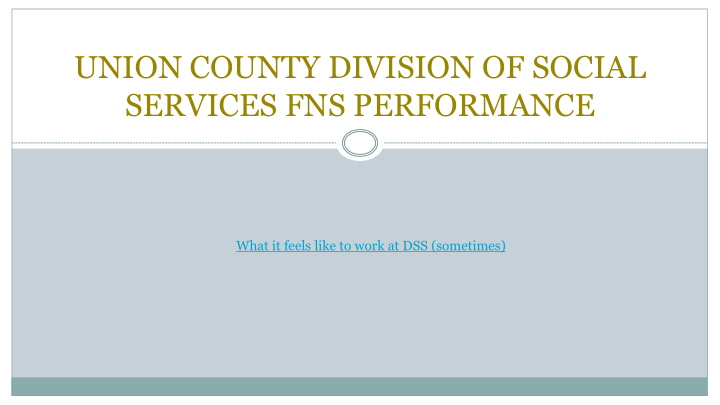



UNION COUNTY DIVISION OF SOCIAL SERVICES FNS PERFORMANCE What it feels like to work at DSS (sometimes)
Team Members Rae Alepa, Director, Division of Social Services Mary Causebrook, Human Service Evaluator Earl Ford, Program Administrator Robin Sheppard, FNS Supervisor Karen Tucker, FNS Supervisor
What we’ve been through… Implementation of NC FAST Loss of experienced workers Increased staff turnover Loss of assistance from Contract Employees Increase in Active Cases Increase in Customers Increase in Applications Inadequate staffing Learning curve for new staff New leadership within the agency – 5 times in 5 years Technology shortfalls New systems – daysheets, Compass, etc.
THEN and NOW – State of our county 2000 2010 Population 2015 Estimated % Increase Population 123,677 201,292 222,742 80.01 Union County is the 3 rd fastest growing county in North Carolina From the year 2000 to the year 2010*: - Persons of Hispanic/Latino Origin saw an increase of 174.54% - Persons aged 5 to 17 saw an increase of 86.93% - Persons aged 65 and over saw an increase of 74.61% These are our most indigent populations and make up 64.6% of FNS recipients in Union County**. *Population statistics obtained from the United States Census Bureau FactFinder. **Recipient data obtained from USDA Profile of SNAP Households, March 2015
THEN and NOW – State of our agency 2007 Active 2016 Active % Change 2007 Active 2016 Active % Change Cases Cases Participants Participants 4,375 8,796 101% 10,476 20,152 92.4% Though the active cases increased from 2007 to 2016 by 101%, the county was unable to increase staffing until this current fiscal year. - An additional 10 positions for FNS were requested, the county approved 5 positions and left 5 in reserve after a reevaluation (to occur around January 2017). - We currently have 25 workers who work with FNS customers - 14 ongoing case managers & 11 application case managers - Training Unit was created: 4 trainers and one program manager (2 current vacancies)
What drives us… 100 90 80 Recertification 70 Timeliness 60 50 40 30 20 10 0
Goals and Objectives Improved and sustained timeliness ratings + Decreased time to process recertifications + Improved Accuracy + Reduction in Caseload Churning rates + = Customer Access Improvement + Increased Customer Satisfaction
Process Improvements to Date October 2014 June 2015 - Present - Implemented Change - Eliminated Change team team and integrated those Universal Concept/Pre *Change team processed workers into either FNS or October 2014 FNS and F&C Changes F&C teams - All caseworkers - Separated Adult Medicaid - FNS and F&C completed F&C Medicaid, from other programs Applications no longer Adult Medicaid, and FNS - All Applications for F&C combined applications and reviews and FNS were combined - FNS and F&C - Recertifications for FNS recertifications remained and F&C were separate separate teams
SNAP Collaborative – Baseline Track 10 applications and 10 recertifications Application process time: 52 minutes Recertification process time: 100 minutes Track worker tasks Majority of tasks were recertifications and phone calls Track method of receipt for recertifications 53% of recertifications are received by way of customer coming into the agency
SNAP Collaborative – Questions Why are recertifications taking longer to process than applications? Duplicates Incorrectly keyed from application What is causing the need for rework? New workers with no experience Lack of training for seasoned staff How can we pend and interview customers the same day the recert is received? PDSA #1
PDSA#1 – Same day processing Step 1 – Have front office ask customer if they wish to have a caseworker review their recert to ensure agency had all verifications If the customer agreed, they were logged in to see the existing triage team 46% of customers agreed to wait to see a worker Step 2 – Test expanded triage unit with 2 caseworkers – two days Workers completed recerts while customer was in their office 65% of recerts completed the same day Step 3 – Test expanded triage unit with all ongoing caseworkers – one week 65% of recerts completed the same day Step 4 – Implementation of full expanded triage unit – one month 60% of recerts completed the same day
RESULTS January 2017 = 100% timeliness
PDSA #2 – What to do about all those mail ins Step 1 – Get data regarding upcoming recertifications √Report created in Date Warehouse Step 2 – Create script for IMC 1 to contact customers √Script created and ready Step 3 – Contact customers to give them information Scheduled to begin Mid-February Step 4 – Track to determine decrease in the need to pend for information Recertifications will be tracked during the month of March
Next Steps – Looking at Accuracy Work with training unit to determine common errors Track amount of time spent on corrections – one week Track actual errors discovered to determined trends Implement more ongoing training Use information from tracking to determine course of action and next PDSA
Where we aim to be
Recommend
More recommend